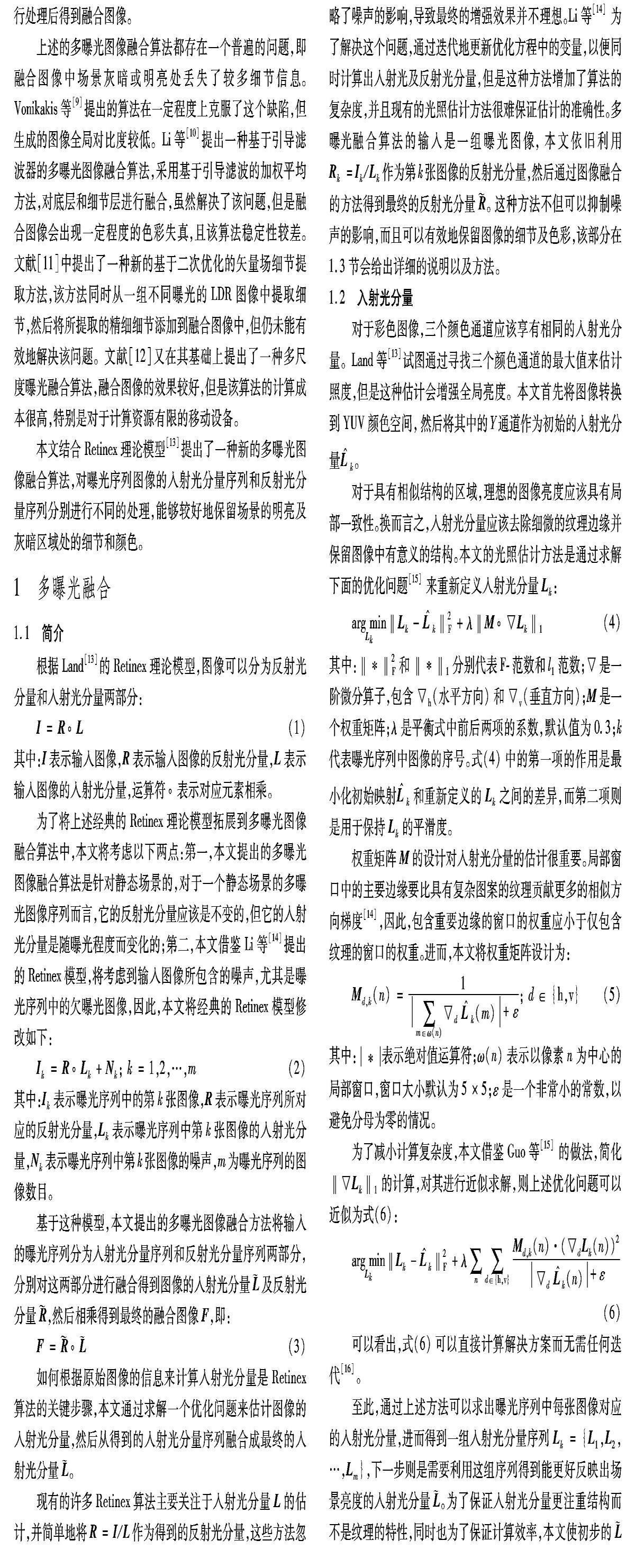基于Retinex理论的多曝光图像融合算法
2019-09-04王克强张雨帅王保群
王克强 张雨帅 王保群



摘 要:多曝光图像融合技术是将一组场景相同但曝光程度不同的图像序列直接融合成为一幅含有更多场景细节信息的高质量图像。针对现有算法局部对比度差和色彩失真的问题,结合Retinex理论模型提出了一种新的多曝光图像融合算法。首先,基于Retinex理论模型,利用光照估计算法将曝光序列图像分为入射光分量序列和反射光分量序列,然后分别采用不同的融合方法对这两组序列进行处理。对于入射光分量,要保证场景的全局亮度的变化特性并且削弱过曝光和欠曝光区域的影响;而对于反射光分量,要采用适度曝光的评价参数来更好地保留场景的色彩及细节信息。分别从主观和客观两方面对所提算法進行了分析。实验结果表明,同传统基于图像域合成的算法相比,该算法在结构相似度(SSIM)上平均提升了1.7%,另外在图像色彩和局部细节上的处理效果更好。
关键词:高动态范围成像;多曝光图像;图像融合;Retinex;曝光适度
Abstract: Multi-exposure image fusion technology directly combines a sequence of images with the same scene but different exposure levels into a high-quality image with more details of scene. Aiming at the problems of poor local contrast difference and color distortion of existing algorithms, a new multi-exposure image fusion algorithm was proposed based on Retinex theoretical model. Firstly, based on Retinex theoretical model, the exposure sequence images were divided into an illumination component sequence and a reflection component sequence by using the illumination estimation algorithm, and then two sets of sequences were processed by different fusion methods. For the illumination component, the variation characteristics of global brightness of scene were guaranteed and the effects of overexposed and underexposed regions were weakened, while for the reflection component, the evaluation parameters of moderate exposure were used to better preserve the color and detail information of scene. The proposed algorithm was analyzed from both subjective and objective aspects. The experimental results show that compared with traditional algorithm based on image domain synthesis, the proposed algorithm has an average increase of 1.7% in Structural SIMilarity (SSIM) and has better effect in the processing of image color and local details.
Key words: high dynamic range imaging; multi-exposure image; image fusion; Retinex; well-exposedness
0 引言
普通数码相机成像的动态范围远低于现实场景的动态范围,其捕捉的画面很难完整地呈现现实场景的所有细节信息。将场景多个不同曝光程度的低动态范围(Low Dynamic Range, LDR)图像融合成高动态范围(High Dynamic Range,HDR)图像是克服相机有限的动态范围并降低照片中噪声的有效方法,这种成像技术称为HDR成像[1]。由于拍摄时的相机抖动以及场景内可能存在运动对象,需要对所有LDR图像先进行对齐[2],然后根据预定义的参考图像同步所有运动对象[3],再将校正后的图像合成HDR图像,以包括所有LDR图像的细节,最后使用色调映射算法[4]将HDR图像最终转换为LDR图像,以便通过常规显示设备来展示。
除了HDR成像技术之外,目前更为流行的一种技术是多曝光图像融合。不同于HDR成像那样需要生成中间HDR图像,多曝光图像融合技术直接从所有LDR图像中合成信息量更大且视觉效果更好的LDR图像。Mertens等[5]在多尺度图像分解下,利用曝光程度、对比度和饱和度的三个质量评价参数来确定给定像素对最终合成图像的贡献程度,利用多分辨率融合有效地保留了全局对比度,但是局部对比度较低。Zhang等[6]提出了一种基于梯度信息的曝光融合方案,认为当像素获得更好的曝光状态时,梯度幅度变得更大,并且随着像素接近曝光过度/曝光不足而逐渐减小。Shen等[7]提出了一种基于概率模型的多曝光图像融合算法,建立了一种广义随机游动框架,通过将融合问题表示为概率估计,计算出两种质量度量下的全局最优解,以此得到最终的合成图像。Ma等[8]提出的方法将每个彩色图像分解为三个概念上独立的分量:信号强度、信号结构和平均强度,对这三个分量分别进行处理后得到融合图像。
